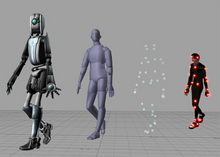
Back تظليل غورو Arabic Gouraud Shading German Sombreado Gouraud Spanish Gouraud-varjostus Finnish Ombrage de Gouraud French Gouraud-árnyalás Hungarian Pencorakan Gouraud ID Gouraud shading Italian グーローシェーディング Japanese 구로 셰이딩 Korean
This article has multiple issues. Please help improve it or discuss these issues on the talk page. (Learn how and when to remove these messages)
|
| Three-dimensional (3D) computer graphics |
|---|
 |
| Fundamentals |
| Primary uses |
| Related topics |

Gouraud shading (/ɡuːˈroʊ/ goo-ROH), named after Henri Gouraud, is an interpolation method used in computer graphics to produce continuous shading of surfaces represented by polygon meshes. In practice, Gouraud shading is most often used to achieve continuous lighting on triangle meshes by computing the lighting at the corners of each triangle and linearly interpolating the resulting colours for each pixel covered by the triangle. Gouraud first published the technique in 1971.[1][2][3] However, enhanced hardware support for superior shading models has yielded Gouraud shading largely obsolete in modern rendering.
- ^ Gouraud, Henri (1971). Computer Display of Curved Surfaces, Doctoral Thesis (Thesis). University of Utah.
- ^ Gouraud, Henri (1971). "Continuous shading of curved surfaces" (PDF). IEEE Transactions on Computers. C-20 (6): 623–629. doi:10.1109/T-C.1971.223313. S2CID 123827991.
- ^ Gouraud, Henri (1998). "Continuous shading of curved surfaces". In Rosalee Wolfe (ed.). Seminal Graphics: Pioneering efforts that shaped the field. ACM Press. ISBN 1-58113-052-X.